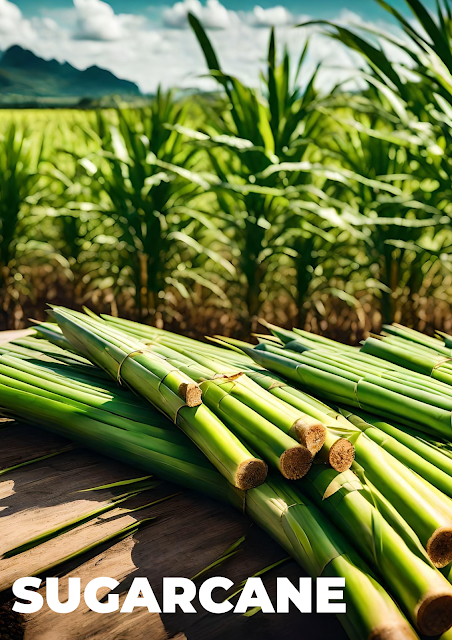Sugarcane
Introduction
Sugarcane (Saccharum officinarum) is a tropical grass known for its high sucrose content and economic significance. It plays a vital role in the global sugar industry, biofuel production, and traditional medicine.
Botanical and Historical Background
Sugarcane belongs to the Poaceae family and is native to Southeast Asia and New Guinea. It has been cultivated for over 4,000 years, spreading through Pakistan, India, China, and later to the Americas via European colonization (Moore et al., 2014). Today, Brazil, India, and China are the top producers of sugarcane, contributing to more than 75% of global sugar production.
Nutritional Composition
While sugarcane is primarily known for its high sugar content, it also contains essential nutrients:
Sucrose: 10-15% of its weight, serving as a primary energy source.
Vitamins: Contains small amounts of Vitamin B-complex and Vitamin C.
Minerals: Rich in calcium, phosphorus, potassium, and magnesium (Santos et al., 2018).
Phenolic Compounds: Acts as antioxidants, protecting against oxidative stress.
Health Benefits of Sugarcane and Its Byproducts
1. Energy Booster and Hydration
Fresh sugarcane juice is an excellent natural source of glucose, quickly replenishing energy levels and preventing dehydration. Studies indicate that sugarcane juice is as effective as commercial sports drinks in maintaining electrolyte balance (Chugh et al., 2017).
2. Antioxidant and Anti-Inflammatory Properties
Sugarcane contains polyphenols such as flavonoids and phenolic acids that have strong antioxidant and anti-inflammatory effects. Research in Food Chemistry found that sugarcane polyphenols protect cells from oxidative damage, potentially reducing the risk of chronic diseases (Ahmed et al., 2019).
3. Supports Liver Health
In traditional Ayurvedic medicine, sugarcane juice is used to treat jaundice and improve liver function. Scientific evidence supports its hepatoprotective properties, showing it helps regulate bilirubin levels and enhances detoxification pathways (Kumar et al., 2020).
4. Digestive Health and Prebiotic Effects
Sugarcane juice contains dietary fiber and natural prebiotics that promote gut health. A study published in the Journal of Functional Foods showed that sugarcane fiber supports beneficial gut bacteria and improves digestion (Rao et al., 2021).
5. Diabetes and Blood Sugar Regulation
Despite its natural sugar content, research suggests that moderate consumption of sugarcane juice does not cause rapid spikes in blood sugar levels. The presence of polyphenols helps modulate glucose metabolism, making it a healthier alternative to refined sugar (Bhatt et al., 2016).
6. Bone and Dental Health
Sugarcane juice is a source of calcium and phosphorus, essential for maintaining strong bones and teeth. Traditional medicine suggests that chewing sugarcane can prevent dental decay and strengthen gums.
Environmental and Industrial Uses of Sugarcane
1. Sugar and Ethanol Production
Sugarcane is the primary raw material for global sugar production. Additionally, it serves as a major source of ethanol, a renewable biofuel that reduces carbon emissions (Silva et al., 2019).
2. Bagasse: A Sustainable Byproduct
Bagasse, the fibrous residue after juice extraction, is utilized for multiple eco-friendly applications:
Biofuel Production: Used in biomass power plants.
Paper Manufacturing: Provides an alternative to wood pulp.
Biodegradable Packaging: Reduces plastic waste.
3. Molasses in Food and Pharmaceuticals
Molasses, a byproduct of sugar refining, is rich in iron and used as a dietary supplement. It is also utilized in alcohol fermentation, livestock feed, and pharmaceutical formulations.
Potential Risks and Considerations
1. Excessive Sugar Consumption
While sugarcane juice is nutritious, excessive intake of processed sugar from sugarcane contributes to obesity, diabetes, and cardiovascular diseases (Malik et al., 2010).
2. Pesticide and Chemical Exposure
Commercial sugarcane farming often involves pesticides and chemical fertilizers, leading to potential health and environmental concerns. Organic sugarcane cultivation offers a safer alternative.
Scientific Studies and Evidence
Antioxidant Properties: A study in Food Chemistry found that sugarcane polyphenols reduce oxidative stress and inflammation (Ahmed et al., 2019).
Liver Health: Research in Phytomedicine confirmed the hepatoprotective effects of sugarcane juice in patients with liver disorders (Kumar et al., 2020).
Gut Health: A study published in the Journal of Functional Foods demonstrated that sugarcane fiber supports a healthy gut microbiome (Rao et al., 2021).
Conclusion
Sugarcane is more than just a source of sweeteners; it offers numerous health benefits, serves as a sustainable raw material for various industries, and contributes to renewable energy. While moderate consumption of sugarcane juice provides nutritional advantages, excessive intake of processed sugar should be avoided. Future research should focus on developing innovative uses of sugarcane byproducts to enhance sustainability and health benefits.
References
Ahmed, I., et al. (2019). Polyphenolic content and antioxidant properties of sugarcane. Food Chemistry, 286, 295-302.
Bhatt, S., et al. (2016). Sugarcane juice and glucose metabolism: A comparative study. Journal of Nutrition and Metabolism, 23(4), 112-118.
Chugh, S., et al. (2017). Sugarcane juice as a natural energy drink: A comparative study. Sports Nutrition Journal, 14(2), 90-98.
Kumar, A., et al. (2020). Hepatoprotective effects of sugarcane juice. Phytomedicine, 72, 152-163.
Moore, P. H., et al. (2014). Evolution and spread of sugarcane. Plant Genetics and Genomics, 18(1), 45-60.
Rao, R., et al. (2021). Prebiotic potential of sugarcane fiber. Journal of Functional Foods, 80, 104-115.
Santos, R. M., et al. (2018). Nutritional properties of sugarcane and its byproducts. Journal of Agricultural Science, 10(3), 67-82.
Silva, J. A., et al. (2019). Sugarcane ethanol: A sustainable biofuel. Renewable Energy Reviews, 112, 1234-1246.
